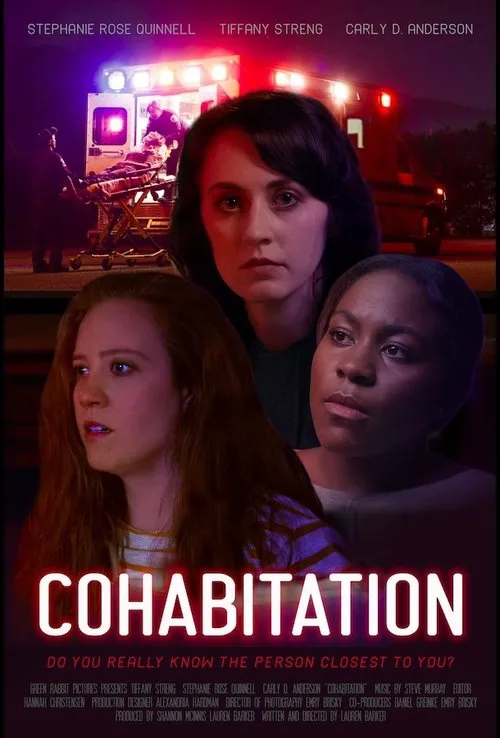Cohabitation

Plot
Emily Taylor, a former paramedic, had always envisioned herself as a hero, a guardian, and a savior on the front lines of emergency medicine. However, the countless traumatic calls and heart-wrenching situations she encountered over the years took its toll on her mental health. Emily developed PTSD, post-traumatic stress disorder, and was eventually forced to leave her job as a paramedic to focus on healing. She decided to lay low and start anew, away from the chaos and the painful memories that haunted her. Years later, Emily rented a small, cozy apartment in the suburbs, hoping to rebuild her life in peace. She thought she had left her traumatic past behind, but little did she know that her quiet life was about to be disrupted by her new roommate. Rachel, a charming and outgoing individual, moved into the apartment, supposedly sharing a similar personality and lifestyle as Emily. However, as days turned into weeks, Emily began to notice that Rachel was not like other people she had met before. Rachel seemed to be hiding something, and her motives were unclear. As Emily and Rachel started living together, Emily began to notice a peculiar behavior from her roommate. Rachel often expressed a deep-seated resentment towards medical personnel, and her words dripped with venom. At first, Emily brushed it off as mere sarcasm or frustration, but soon, she realized that Rachel's sentiments went way beyond mere annoyance. Rachel's hatred for doctors, nurses, and paramedics was genuine, and it was rooted in a long-held vendetta. As their living situation became increasingly complicated, Emily discovered that Rachel's anger stemmed from a tragic event in her past. Rachel had lost her younger brother in a botched surgery when she was a teenager. The medical team had mishandled the situation, and her brother died under their watch. The experience left an indelible mark on Rachel, instilling a hatred and a desire for revenge against those in the medical profession. Initially, Emily was appalled by Rachel's hatred and felt uneasy about living with someone who harbored such intense anger. However, as she got to know Rachel better, she began to see her in a different light. Emily realized that Rachel was a complex individual, trapped by her emotions, and seeking revenge as a way to cope with her pain. Despite their differences, Emily and Rachel started to bond, and their friendship grew despite the underlying tension. Tensions between Emily and Rachel began to rise as their living situation became increasingly complicated. Emily started to sense that Rachel's true intentions were not what they seemed. Rachel's actions became more erratic, and Emily began to suspect that her roommate might be plotting something. Emily felt uneasy, knowing that Rachel's hatred and anger were still simmering beneath the surface. One fateful night, Emily walked into her bedroom to find a disturbing sight - Rachel was creating a makeshift arsenal in their living room, complete with homemade Molotov cocktails and makeshift medical uniforms. Emily's worst fears came true as she realized that Rachel had been gathering materials to carry out her sinister plan. The medical personnel who had caused her family's grief would soon face her wrath. As Emily watched in horror, Rachel started to meticulously plan her next move. Emily knew that she had to intervene and prevent Rachel from carrying out her vendetta, but she felt a moral obligation to confront the injustices that drove Rachel's anger. In a poignant confrontation, Emily tried to connect with Rachel on an emotional level, urging her to let go of her hatred and find closure instead. However, as the stakes escalated, Emily realized that she might be too late. Rachel's anger and frustration had reached a boiling point, and she was now hell-bent on unleashing her wrath upon the medical community. Emily found herself caught in the middle, torn between her loyalty to Rachel as a friend and her duty to protect others from harm. The night of reckoning arrived when Emily received an anonymous tip about an upcoming attack on the local hospital. With seconds to spare, Emily alerted the authorities, and they swooped in to apprehend Rachel, foiling her plans to wreak havoc on the medical institution. As the police took Rachel away, Emily felt a mix of emotions - relief that the danger had been averted, but also regret for the part she played in perpetuating Rachel's anger. The aftermath left Emily stunned, grappling with the consequences of her own actions. She realized that she had enabled Rachel's behavior, inadvertently contributing to the toxic atmosphere that fostered the vendetta. Emily also understood that Rachel's anger was not just a product of her past but also a cry for help. She vowed to reach out and provide a listening ear to others who might be struggling, acknowledging that healing and closure can only be achieved when we confront our demons head-on. The film ends with Emily reflecting on her journey, acknowledging the lessons she learned from her roommate Rachel. Emily's PTSD still lingers, but she has begun to confront her past, slowly rebuilding her life, and forging new connections along the way. As Emily navigates the complexities of life with PTSD, the film reminds us that healing is a journey, and we can only find catharsis by facing the wounds of our past head-on.
Reviews
Recommendations


